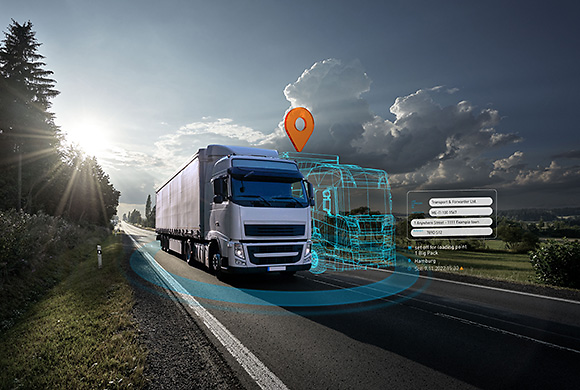What is sustainable logistics?

The fight against climate change is impossible to win without sustainable logistics
We're all experiencing the effects of climate change: summers are getting hotter, rivers are drying up and sudden, extreme weather events are destroying harvests and with them, entire livelihoods, such as with the floodings of the Eifel in 2021 as well as of the Adria and in Bulgaria in September this year. In such a context, a course correction is inevitable. The transformation must be cross-sector, including both the transport and distribution sectors. It is precisely for this reason that many businesses are looking into sustainable logistics, coming up with their own solutions: alternative transport possibilities, alternative drives, digitisation of internal processes, etc.
What is sustainable logistics?
On 28 November 2019, the European Union launched an ambitious project: the European Green Deal. The European member states have committed to achieve net zero emissions by 2050 and to halve them by 2030. The decarbonisation process in Europe also incorporates sustainable logistics. How will this play out?
The new green logistics involves implementing a sustainable supply chain. This means that supply chains are designed to have a minimal effect on the environment. This strategy has now been taken up by all businesses pursuing ESG logistics. This abbreviation stands for Environmental, Social and Governance.
The theory was developed in the 1990s on the basis of the Triple Bottom Line concept, which is also known as People, Planet and Profit. These three elements are key to assessing how sustainable a business's investments are. The idea behind ESG logistics is very simple: businesses generate good profits when they are able to create value, not just for themselves, but also for their employees, customers, suppliers and society in general, including the environment.
Sustainable logistics companies have a competitive advantage. Their utilisation of reusable materials and renewable energies helps to to reduce material and energy costs. But it's not just about savings: choosing ecological sustainability also improves the brand image, especially currently, when the green transformation of logistics is still in its infancy. Join TIMOCOM and be a pioneer in digitising and streamlining processes and avoiding empty trips!
How do you create a sustainable supply chain?
Let's have a closer look at the different measures needed to create a sustainable supply chain. The following elements are crucial for green logistics:
Sustainable transport
Technology to optimise logistics processes
The use of sustainable packaging
Optimising last mile logistics from a green perspective
Ecologically sustainable warehouses
Green logistics transportation
One of the key aspects of sustainable logistics is definitely revamping fleets and transportation strategies. According to an estimation by the ITF (International Transport Forum), vehicles used in freight transport use up to 2.9 billion tonnes of CO² every year. Of these emissions, 62% come from road transport, 27% from maritime transport, 6% from air transport, 3% from rail transport and finally 2% from inland waterways transport.
From this data, it is plain to see that more extensive use of rail transport would benefit the environment. Only 13% of raw materials in Europe are currently transported by rail. In short, loads must be distributed more evenly across different modes of transport. In this regard, green logistics has an advantage: intermodality: the choice of intermodal forms of transport (e.g. combination of road and rail) helps not only to reduce emissions, but also to decongest transportation routes in large urban centres.
Trucks are the most popular mode of transport: they can be used flexibly and can travel directly from production to processing sites in order to transport goods/freight. Truck manufacturers are embarking on new experiments in order to become sustainable through the use of electronic or hydrogen motors. Discussions surrounding new ecological motorways have also been taking place over the past few years. These are connected by a network of electricity cables, which trucks can connect to and disconnect from as required. Sweden is one of the counties at the forefront of this kind of experiment and has already successfully tested its first eHighways. There are also test stretches in Germany.
The main concern as to whether all these innovations will mean that net-zero can be achieved by that not too far off date 2050 remains.
Technology, sustainable infrastructure and recycling
Sustainable logistics is not just about using eco-friendlier transportation. The concept of ecological sustainability is being applied to every aspect of the supply chain, including warehouses.
Businesses taking up the green cause are also renovating their warehouses so they can be “certified” as sustainable. These new warehouses are high-rise facilities, giving them larger capacities, and are built using sustainable construction materials. Technology plays a key role when redesigning these infrastructures. This comes in the form of smart electric systems that only illuminate the areas in use, or robotic solutions that fully automate warehouse and switching procedures.
All these innovations reduce energy consumption: crucial for both business and environment. New technological applications help optimise loads. Over recent years, cutting-edge software has been developed, enabling goods on trucks and in containers to be streamlined, reducing the number of vehicles used in the process. This is also possible with additional cargoes and freight for the return trip. The TIMOCOM Marketplace offers exactly this!
Packaging is also important in the logistics sector's green revolution. By using packaging fully made from reusable material, it is possible to reduce environmental damage and at the same time initiate a positive dynamic in the circular economy. When a piece of packaging has fulfilled its primary function, it can be used to manufacture new items or simply to generate energy.
TIMOCOM is playing a key role in the area of sustainable logistics by providing thousands of users who every day choose freight exchange with the best technology possible. With the Marketplace functions, you can better organise your dispatches. This means you can avoid empty trips, which are both uneconomical and harmful to the environment. You can also optimise routes and costs. Sign up today and discover all our services.
